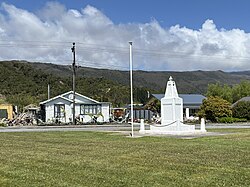Waimangaroa | |
|---|---|
 Denniston Road Scenic Reserve | |
 | |
| Coordinates: 41°42′46″S171°45′46″E / 41.71278°S 171.76278°E | |
| Country | New Zealand |
| Region | West Coast |
| District | Buller District |
| Ward | Seddon |
| Electorates | |
| Government | |
| • Territorial Authority | Buller District Council |
| • Regional council | West Coast Regional Council |
| • Mayor of Buller | Jamie Cleine |
| • West Coast-Tasman MP | Maureen Pugh |
| • Te Tai Tonga MP | Tākuta Ferris |
| Area | |
• Total | 1.58 km2 (0.61 sq mi) |
| Population (June 2024) [2] | |
• Total | 220 |
| • Density | 140/km2 (360/sq mi) |
Waimangaroa is a small town located on the West Coast of New Zealand.
Contents
The township lies on the south-west bank of the Waimangaroa River, at the western foot of the Denniston Plateau. It is 17 kilometres (11 mi) to the north east of Westport and 13 km south-east of Granity. The abandoned coaltown of Denniston is about 5 kilometres (3.1 mi) to the south-east. [3] [4] The Bridle Track, a scenic bush track, leads south-east along the Denniston Incline into the foothills of the Mt William Range, to Denniston. [5] The Stockton mine, a large open cast coal mine, is operated in the vicinity by Solid Energy. [6]
The Ngakawau Branch, a branch line railway, runs through the town. It opened to Waimangaroa on 5 August 1876; it formerly ran to Seddonville but now terminates in Ngakawau. From 24 October 1879 until 16 August 1967, Waimangaroa was also the junction for the Conns Creek Branch, which ran east alongside the Waimangaroa River to the foot of the Denniston Incline. Passenger services ceased on the Conns Creek Branch in 1931 and Ngakawau Branch on 14 October 1946. Since this time, the railway through Waimangaroa has almost solely conveyed coal.
The beaches to the west have dangerous currents and are not safe for swimming. [7]
